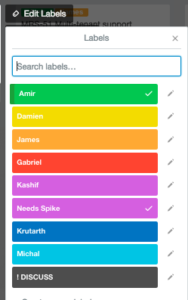Using story points for estimation can get stale after a while. When Kyle Winter mentioned relative mass estimation on our company agile slack channel I was wondering how to implement this with a distributed team. Below are the details and results of our experiment.
If you are not familiar with relative mass estimation please read 3 Powerful Estimation Techniques for Agile Teams or Affinity Estimating: A How-To
Experiment
We used a trello board for the estimation. It is free, simple and fast. We created a list with the stories we wanted to estimate and a series of list from XS through XL. I put a couple of reference stories in the M list to serve as a reference point for the a medium story.
Our first challenge was how someone could ‘turn a card sideways’ (to indicate a disagreement or question on the estimate). We solved this by adding a “Discuss” label.

To avoid everyone considering the same cards we added a label for every participant to allow them to claim he card. Each team member picked stories to size one at a time. Once all stories were sized each team member reviewed the estimates done by others. The entire exersize was done quetly without discussions. We set a 15 minute timebox but all stories were sized before the time was up. After the sizing we discussed the stories which had the Discuss label.
Result
We were able to estimate a lot more stories in our timebox. The team expressed some concern about the estimate quality because most of the estimation was done quietly. We discussed the stories in more depth when we did planning poker. We also lost the equal voice of planning poker.
On the whole the team liked the experiment and wants to try it again. We are considering splitting the session into a story discussion and an estimating timebox. The aim is to address the concern that stories were not sufficiently discussed by the team.
Trello worked well as a tool.
JIRA → Trello
If you use JIRA you can easily export your story descriptions into trello with the following simple steps:
- Create the list of stories you want to copy to trello
- Export the list to excel
- If you do not have excel installed you can upload the file into google docs and use Google Sheets
- In excel select the the keys and descriptions of the cards
- Paste into a new card in the list
- Trello will give you the option to generate multiple cards


